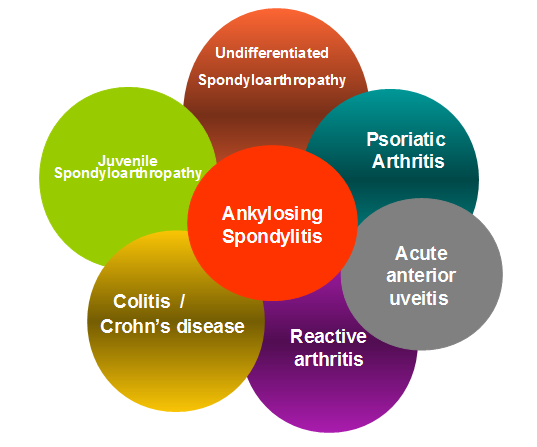What are the Spondyloarthropathies?
Introduction
This term is a bit of a mouthful- even for doctors!
"Spondylo" refers to the spine and "arthropathy" means arthritis.
In the 1970s in Leeds, Drs Moll and Wright knew that an inflammatory condition called Ankylosing Spondylitis manifested mostly with spinal inflammation.
The Spondyloarthropathies
They noted that spinal inflammation also occurred in other conditions that showed overlapping features and they coined the term Spondylarthropathy.
 |
| This diagram shows the overlap between Ankylosing Spondylitis and others diseases that occur in the same patient or within families. However, when this Spondyloarthropathy concept was described in Leeds in the UK in the 1970s, the exact link between the conditions was not known. |
It was also noted that these patients had:
- Negative tests for Rheumatoid Arthritis
- A tendency towards swelling of the large joints such as knees and ankles.
- A link with preceding infections but live germs were not present in the joints.
- A link with enthesitis- but this was not too common.
- Shortly after it was discovered that these conditions were linked to a gene called HLA-B27
The unifying basis for inflammation at these sites remained enigmatic.
Central role of the Enthesis in Spondyloarthropathy Concept
It emerged in the mid to late 1990s that enthesitis was the key pathological lesion in Spondyloarthropathy.
All of the Spondyloarthropathy disease manifestations could be put into a unifying scheme as shown below.
 |
| It is now known that the common factor is a tendency to develop disease at sites of high mechanical stress. The enthesis is such a site of high stressing but there are others including the bone in the sacroiliac joint in the low back. Collectively the Spondyloarthropathies are associated germs, especially bacteria. When tissue barriers are damaged then bits of bacterial debris or junk get deposited at insertions. This interaction between germ components and the enthesis is associated with disease. This Unifying Concept emerged in Leeds in the UK in 2001. |
It is now clear that all of these conditions are not just related to spinal inflammation but more specifically enthesitis and enthesopathy.
The link between enthesopathy and Psoriatic Arthritis, Ankylosing Spondylitis, Reactive Arthritis and Undifferentiated Spondyloarthropathy is well established.
In recent years it has been proven in the other Spondyloarthropathies.
Even in subjects with Crohns Disease or Ulcerative Colitis that is well treated there is lots of evidence for abnormalities of the enthesis on Ultrasound scanning [1].
Likewise in subjects who see doctors with red eyes due to anterior uveitis there is often silent enthesopathy in the legs as determined by Ultrasound [2].
Enthesopathy is the key lesion in all forms of Spondyloarthropathy and does not appear to differ in magnitude between patients with spinal disease or disease of the lower limbs or both [3].
So Spondyloarthropathy describes arthritis centrally linked to enthesis inflammation.
References
